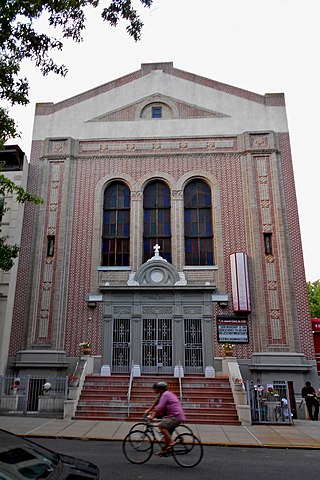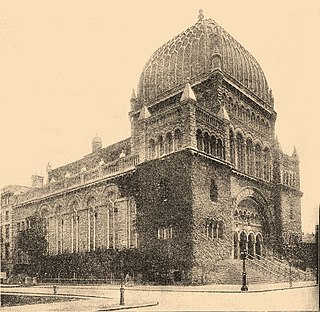
Congregation Emanu-El of New York is the first Reform Jewish congregation in New York City. It has served as a flagship congregation in the Reform branch of Judaism since its founding in 1845. The congregation uses Temple Emanu-El of New York, one of the largest synagogues in the world.

Congregation Kehilath Jeshurun is a Modern Orthodox Jewish synagogue at 126 East 85th Street on the Upper East Side of Manhattan in New York City, New York, United States. The synagogue was founded in 1872. The synagogue is closely affiliated with the Ramaz School. The lower school is co-located in an adjacent building and is across the street from the middle school.

Congregation Ohab Zedek, sometimes abbreviated as OZ and formally known as the First Hungarian Congregation Ohab Zedek, is an Modern Orthodox Jewish congregation and synagogue located at 118 West 95th Street, Upper West Side, in Manhattan, New York City, New York, United States. The congregation is known for its lively, youthful congregation. Founded in 1873, it moved to its current location on in 1926. The current clergy are Rabbi Allen Schwartz, Senior Rabbi and Rabbi Jack Varon, assistant Rabbi.

The Angel Orensanz Center is an art and performance space at 172 Norfolk Street, between Stanton Street and East Houston Street, on the Lower East Side of Manhattan in New York City. It was originally built as a synagogue, running through a succession of congregations and continues to be used as one occasionally as The Shul of New York.

Meserich Synagogue, Meserich Shul or Meseritz Shul, also known as Edes Israel Anshei Mesrich, Edath Lei'Isroel Ansche Meseritz or Adas Yisroel Anshe Mezeritz, is an Orthodox Jewish synagogue located at 415 East 6th Street, in the East Village of Manhattan, New York City, New York, United States.

B'nai Jeshurun is a non-denominational Jewish synagogue located at 257 West 88th Street and 270 West 89th Street, on the Upper West Side of Manhattan, in New York City, New York, United States.

Ansche Chesed is a Conservative synagogue located at West End Avenue and 100th Street on the Upper West Side of Manhattan in New York City, New York, United States.

St. Leonard's Anglican Church, previously known as Shaari Zedek Synagogue and Congregation Achavat Achim, is a historic synagogue and church building at 767 Putnam Ave. in Bedford-Stuyvesant, Brooklyn, New York. Built in 1909–1910, the building served as a synagogue until 1944, when it was bought by an Afro-Caribbean church in the Anglican tradition. The church has been listed on the National Register of Historic Places since 2009 under the name "Shaari Zedek Synagogue", although it has been a church for significantly longer than it was a synagogue.
Anshe Chesed Fairmount Temple, commonly called the Fairmount Temple, is a Reform Jewish congregation and synagogue, located at 23737 Fairmount Boulevard, in Beachwood, Ohio, in the United States. The congregation is the oldest Jewish congregation in the Cleveland area. The congregation's membership exceeded 2,000 families in the mid-1990s.
The Oheb Zedek Cedar Sinai Synagogue is a Modern Orthodox Jewish synagogue located at 23749 Cedar Road, in Lyndhurst, an eastern suburb of Cleveland, Ohio, in the United States. The congregation was formed in 2012, through a merger of two congregations dating from 1887.

Alexander Saeltzer was a German-American architect active in New York City in the 1850s and 1860s. His work includes the Anshe Chesed Synagogue, Academy of Music, Theatre Francais, the Duncan, Sherman & Company building and the South Wing of the Romanesque revival structure at 425 Lafayette Street built between 1853 and 1881 as the Astor Library.

The Jewish community of the Greater Cleveland area comprises a significant ethnoreligious population of the U.S. State of Ohio. It began in 1839 by immigrants from Bavaria and its size has significantly grown in the decades since then. In the early 21st century, Ohio's census data reported over 150,000 Jews, with the Cleveland area being home to more than 50% of this population. As of 2018, Greater Cleveland is the 23rd largest Jewish community in the United States. As of 2023, the Cleveland Jewish Community is estimated to be about 100,000 people.

The Podhajcer Shul is a former Orthodox synagogue, now private residence, located at 108 East First Street, just north of Houston Street, in the Lower East Side neighborhood of Manhattan, in New York City, New York, in the United States.

Temple Beth-El was a Reform Jewish congregation and synagogue located at 945 Fifth Avenue and 76th Street in the Upper East Side of Manhattan in New York City, New York, in the United States. The synagogue operated between 1891 until c. 1929, and was demolished in 1947. The Temple Beth-El congregation merged with Congregation Emanu-El of New York in 1927.
Dutch people have had a continuous presence in New York City for nearly 400 years, being the earliest European settlers. New York City traces its origins to a trading post founded on the southern tip of Manhattan Island by Dutch colonists in 1624. The settlement was named New Amsterdam in 1626 and was chartered as a city in 1653. Because of the history of Dutch colonization, Dutch culture, politics, law, architecture, and language played a formative role in shaping the culture of the city. The Dutch were the majority in New York City until the early 1700s and the Dutch language was commonly spoken until the mid to late-1700s.
Philip Klein was a Hungarian-born rabbi who ministered in the Russian Empire and America.













